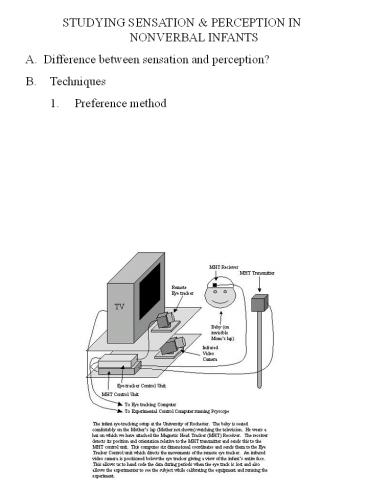STUDYING SENSATION - PowerPoint PPT Presentation
Title:
STUDYING SENSATION
Description:
STUDYING SENSATION & PERCEPTION IN NONVERBAL INFANTS. A. Difference between sensation and perception? Techniques. Preference method ... – PowerPoint PPT presentation
Number of Views:31
Avg rating:3.0/5.0
Title: STUDYING SENSATION
1
- STUDYING SENSATION PERCEPTION IN NONVERBAL
INFANTS - A. Difference between sensation and perception?
- Techniques
- Preference method
2
- STUDYING SENSATION PERCEPTION IN NONVERBAL
INFANTS - A. Difference between sensation and perception?
- Techniques
- Preference method
- Habituation method
3
- STUDYING SENSATION PERCEPTION IN NONVERBAL
INFANTS - A. Difference between sensation and
perception? - Techniques
- Preference method
- Habituation method
- Evoked potentials
- High-Amplitude sucking
4
- INFANT SENSORY CAPABILITIES
- Vision in Newborns
- 1. Least developed of senses
- 2. Acuity (20/600)
5
- INFANT SENSORY CAPABILITIES
- Vision in Newborns
- 1. Least developed of senses
- 2. Acuity (20/600)
- 3. Color Vision
- 4. Visual Contrast
- 5. Brightness Discrimination
6
- INFANT SENSORY CAPABILITIES
- Vision in Newborns
- Hearing in Newborns
- Discrimination
- Voices
- Language
- Hearing loss/Ear infections
7
- INFANT SENSORY CAPABILITIES
- Vision in Newborns
- Hearing in Newborns
- C. Taste and Smell
- 1. Preferences
- 2. Discrimination
8
MOMS SENSORY CAPABILITIES!
9
- INFANT SENSORY CAPABILITIES
- A. Vision in Newborns
- Hearing in Newborns
- C. Taste and Smell
- D. Touch, Temperature Pain
- 1. Sensitivity
- 2. Circumcision
10
INFANT PERCEPTION Perception The
interpretation of sensory input by the
brain. Activities to illustrate the importance
of perception and expectation.
11
INFANT PERCEPTION Reality.does an objective
reality exist that our senses detect and
classify OR Is reality what we create to
make sense of ambiguous stimuli? Modern
Theories of Perceptual Development Enrichment
Theory Differentiation Theory
12
(No Transcript)
13
INFANT PERCEPTION
- Visual Perception
- Perception of Patterns/Forms
- 0-2 months
- 2-12 months
- Face perception
14
INFANT PERCEPTION
- Visual Perception
- Perception of Patterns/Forms
- Perception of 3-D Space
Basic Definitions Stereopsis fusion of two
flat images to produce one image that has
depth Pictorial (perspective) cues depth and
distance cues
15
INFANT PERCEPTION
Pictorial (perspective) cues depth and
distance cues
16
INFANT PERCEPTION
- Visual Perception
- Perception of Patterns/Forms
- Perception of 3-D Space
Basic Definitions Stereopsis fusion of two
flat images to produce one image that has
depth Pictorial (perspective) cues depth and
distance cues Visual looming object looks
bigger as it draws closer to the face Kinetic
cues created by movements of objects or body
17
INFANT PERCEPTION
- Visual Perception
- Perception of Patterns/Forms
- Perception of 3-D Space
- Early use of Kinetic cues
- Size Constancy
- Pictorial Cues
- Depth Perception
18
INFANT PERCEPTION
Depth Perception
19
INFANT PERCEPTION
Intermodal Perception the ability to use one
sensory modality to identify a stimulus or
pattern of stimuli that is already familiar
through another modality. When do babies
display these abilities?
20
Neurological Effects of Visual Deprivation Visua
l system requires patterned stimulation for
normal development - chimp studies -
cataracts - kittens
21
PRINCIPLES OF LEARNING Habituation to stop
attending or responding to sensory stimulation
that is presented over and over. -
developmental trends - individual differences
22
PRINCIPLES OF LEARNING 1. Classical
conditioning Stimulus elicits Response
23
PRINCIPLES OF LEARNING 1. Classical
conditioning Stimulus elicits
Response Unconditioned Stimulus (UCS)
Unconditioned Response (UCR)
24
PRINCIPLES OF LEARNING 1. Classical
conditioning Stimulus elicits
Response Unconditioned Stimulus (UCS)
Unconditioned Response (UCR) Neutral Stimulus
UCS UCR
(Neutral Stimulus becomes Conditioned
Stimulus)
25
PRINCIPLES OF LEARNING 1. Classical
conditioning Stimulus elicits
Response Unconditioned Stimulus (UCS)
Unconditioned Response (UCR) Neutral Stimulus
UCS UCR
(Neutral Stimulus becomes Conditioned
Stimulus)
Conditioned Stimulus (CS) Conditioned
Response (CR)
26
PRINCIPLES OF LEARNING 1. Classical
conditioning Stimulus elicits
Response Unconditioned Stimulus (UCS)
Unconditioned Response (UCR) Neutral Stimulus
UCS UCR
(Neutral Stimulus becomes Conditioned
Stimulus)
Conditioned Stimulus (CS) Conditioned
Response (CR) Example Pavlov's dogs Meat
powder (UCS) Salivation (UCR)
27
PRINCIPLES OF LEARNING 1. Classical
conditioning Stimulus elicits
Response Unconditioned Stimulus (UCS)
Unconditioned Response (UCR) Neutral Stimulus
UCS UCR
(Neutral Stimulus becomes Conditioned
Stimulus)
Conditioned Stimulus (CS) Conditioned
Response (CR) Example Pavlov's dogs Meat
powder (UCS) Salivation (UCR) Bell (Neutral)
Powder (UCS) Salivation (UCR)
28
PRINCIPLES OF LEARNING 1. Classical
conditioning Stimulus elicits
Response Unconditioned Stimulus (UCS)
Unconditioned Response (UCR) Neutral Stimulus
UCS UCR
(Neutral Stimulus becomes Conditioned
Stimulus)
Conditioned Stimulus (CS) Conditioned
Response (CR) Example Pavlov's dogs Meat
powder (UCS) Salivation (UCR) Bell (Neutral)
Powder (UCS) Salivation (UCR) Bell
(CS) Salivation (CR)
29
PRINCIPLES OF LEARNING 2. Operant
(instrumental) conditioning (Trial-and-error
learning) Response produces Reinforcement
Stimulus R Response (emitted) R
is rewarding R- is aversive
R-
B.F. Skinner
30
PRINCIPLES OF LEARNING Possible Consequences of
Behavior Following Behavior, Type of
Stimulus Stimulus Is Reward()
Aversive(-) Presented Positive
Punishment Reinforcement Removed Extinction
Negative Reinforcement
31
- PRINCIPLES OF LEARNING
- Operant (instrumental) conditioning
(Trial-and-error learning) - Applications to child development
- - Can infants remember?
- - How to punish effectively?
32
PRINCIPLES OF LEARNING Observational Learning
learning that results from observing the behavior
of others - Newborn imitation - Deferred
imitation

